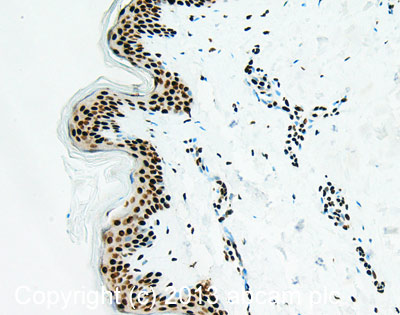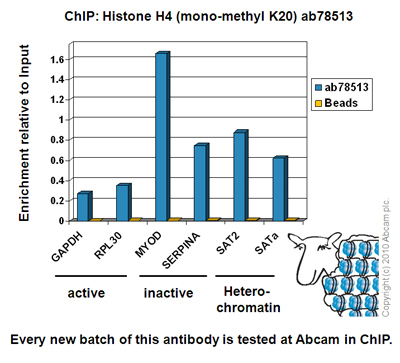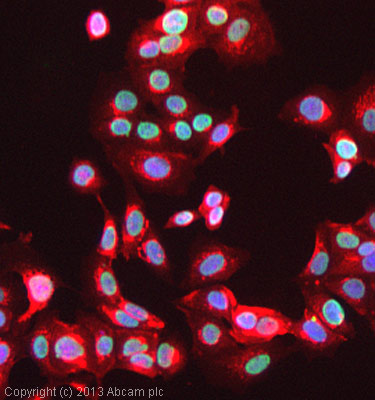
IHC image of Histone H4 (mono methyl K20) staining in Human normal skin formalin fixed paraffin embedded tissue section, performed on a Leica Bond™ system using the standard protocol F. The section was pre-treated using heat mediated antigen retrieval with sodium citrate buffer (pH6, epitope retrieval solution 1) for 20 mins. The section was then incubated with ab78513, 5µg/ml, for 15 mins at room temperature and detected using an HRP conjugated compact polymer system. DAB was used as the chromogen. The section was then counterstained with haematoxylin and mounted with DPX. For other IHC staining systems (automated and non-automated) customers should optimize variable parameters such as antigen retrieval conditions, primary antibody concentration and antibody incubation times.
![All lanes : Anti-Histone H4 (mono methyl K20) antibody [5E10-D8] - ChIP Grade (ab78513) at 1 µg/mlLane 1 : Calf Thymus Histone Preparation Nuclear Lysate (ab121)Lane 2 : Calf Thymus Histone Preparation Nuclear Lysate (ab121) with Human Histone H4 peptide (ab14963) at 0.5 µg/mlLane 3 : Calf Thymus Histone Preparation Nuclear Lysate (ab121) with Human Histone H3 (mono methyl K4) peptide (ab1340) at 0.5 µg/mlLane 4 : Calf Thymus Histone Preparation Nuclear Lysate (ab121) with Human Histone H3 (di methyl K4) peptide (ab7768) at 0.5 µg/mlLane 5 : Calf Thymus Histone Preparation Nuclear Lysate (ab121) with Human Histone H3 (tri methyl K4) peptide (ab1342) at 0.5 µg/mlLane 6 : Calf Thymus Histone Preparation Nuclear Lysate (ab121) with Human Histone H4 (mono methyl K20) peptide (ab17043) at 0.5 µg/mlLane 7 : Calf Thymus Histone Preparation Nuclear Lysate (ab121) with Histone H4 peptide (17-24) - di methyl K20 at 0.5 µg/mlLane 8 : Calf Thymus Histone Preparation Nuclear Lysate (ab121) with Hum](http://www.bioprodhub.com/system/product_images/ab_products/2/sub_3/2316_Histone-H4-Primary-antibodies-ab78513-2.jpg)
All lanes : Anti-Histone H4 (mono methyl K20) antibody [5E10-D8] - ChIP Grade (ab78513) at 1 µg/mlLane 1 : Calf Thymus Histone Preparation Nuclear Lysate (ab121)Lane 2 : Calf Thymus Histone Preparation Nuclear Lysate (ab121) with Human Histone H4 peptide (ab14963) at 0.5 µg/mlLane 3 : Calf Thymus Histone Preparation Nuclear Lysate (ab121) with Human Histone H3 (mono methyl K4) peptide (ab1340) at 0.5 µg/mlLane 4 : Calf Thymus Histone Preparation Nuclear Lysate (ab121) with Human Histone H3 (di methyl K4) peptide (ab7768) at 0.5 µg/mlLane 5 : Calf Thymus Histone Preparation Nuclear Lysate (ab121) with Human Histone H3 (tri methyl K4) peptide (ab1342) at 0.5 µg/mlLane 6 : Calf Thymus Histone Preparation Nuclear Lysate (ab121) with Human Histone H4 (mono methyl K20) peptide (ab17043) at 0.5 µg/mlLane 7 : Calf Thymus Histone Preparation Nuclear Lysate (ab121) with Histone H4 peptide (17-24) - di methyl K20 at 0.5 µg/mlLane 8 : Calf Thymus Histone Preparation Nuclear Lysate (ab121) with Hum

Chromatin was prepared from HeLa cells according to the Abcam X-ChIP protocol. Cells were fixed with formaldehyde for 10 minutes. The ChIP was performed with 25µg of chromatin, 5µg of ab78513 (blue), and 20µl of Protein A/G sepharose beads. No antibody was added to the beads control (yellow). The immunoprecipitated DNA was quantified by real time PCR (Taqman approach for active and inactive loci, Sybr green approach for heterochromatic loci). Primers and probes are located in the first kb of the transcribed region.
![Overlay histogram showing HeLa cells stained with ab78513 (red line). The cells were fixed with 80% methanol (5 min) and then permeabilized with 0.1% PBS-Tween for 20 min. The cells were then incubated in 1x PBS / 10% normal goat serum / 0.3M glycine to block non-specific protein-protein interactions followed by the antibody (ab78513, 1µg/1x106 cells) for 30 min at 22ºC. The secondary antibody used was DyLight® 488 goat anti-mouse IgG (H+L) (ab96879) at 1/500 dilution for 30 min at 22ºC. Isotype control antibody (black line) was mouse IgG1 [ICIGG1] (ab91353, 2µg/1x106 cells) used under the same conditions. Acquisition of >5,000 events was performed.](http://www.bioprodhub.com/system/product_images/ab_products/2/sub_3/2318_Histone-H4-Primary-antibodies-ab78513-5.jpg)
Overlay histogram showing HeLa cells stained with ab78513 (red line). The cells were fixed with 80% methanol (5 min) and then permeabilized with 0.1% PBS-Tween for 20 min. The cells were then incubated in 1x PBS / 10% normal goat serum / 0.3M glycine to block non-specific protein-protein interactions followed by the antibody (ab78513, 1µg/1x106 cells) for 30 min at 22ºC. The secondary antibody used was DyLight® 488 goat anti-mouse IgG (H+L) (ab96879) at 1/500 dilution for 30 min at 22ºC. Isotype control antibody (black line) was mouse IgG1 [ICIGG1] (ab91353, 2µg/1x106 cells) used under the same conditions. Acquisition of >5,000 events was performed.

ICC/IF image of ab78513 stained MCF7 cells. The cells were 100% methanol fixed (5 min) and then incubated in 1%BSA / 10% normal goat serum / 0.3M glycine in 0.1% PBS-Tween for 1h to permeabilise the cells and block non-specific protein-protein interactions. The cells were then incubated with the antibody (ab78513, 5µg/ml) overnight at +4°C. The secondary antibody (green) was ab96879, DyLight® 488 goat anti-mouse IgG (H+L) used at a 1/250 dilution for 1h. Alexa Fluor® 594 WGA was used to label plasma membranes (red) at a 1/200 dilution for 1h. DAPI was used to stain the cell nuclei (blue) at a concentration of 1.43µM.

![All lanes : Anti-Histone H4 (mono methyl K20) antibody [5E10-D8] - ChIP Grade (ab78513) at 1 µg/mlLane 1 : Calf Thymus Histone Preparation Nuclear Lysate (ab121)Lane 2 : Calf Thymus Histone Preparation Nuclear Lysate (ab121) with Human Histone H4 peptide (ab14963) at 0.5 µg/mlLane 3 : Calf Thymus Histone Preparation Nuclear Lysate (ab121) with Human Histone H3 (mono methyl K4) peptide (ab1340) at 0.5 µg/mlLane 4 : Calf Thymus Histone Preparation Nuclear Lysate (ab121) with Human Histone H3 (di methyl K4) peptide (ab7768) at 0.5 µg/mlLane 5 : Calf Thymus Histone Preparation Nuclear Lysate (ab121) with Human Histone H3 (tri methyl K4) peptide (ab1342) at 0.5 µg/mlLane 6 : Calf Thymus Histone Preparation Nuclear Lysate (ab121) with Human Histone H4 (mono methyl K20) peptide (ab17043) at 0.5 µg/mlLane 7 : Calf Thymus Histone Preparation Nuclear Lysate (ab121) with Histone H4 peptide (17-24) - di methyl K20 at 0.5 µg/mlLane 8 : Calf Thymus Histone Preparation Nuclear Lysate (ab121) with Hum](http://www.bioprodhub.com/system/product_images/ab_products/2/sub_3/2316_Histone-H4-Primary-antibodies-ab78513-2.jpg)

![Overlay histogram showing HeLa cells stained with ab78513 (red line). The cells were fixed with 80% methanol (5 min) and then permeabilized with 0.1% PBS-Tween for 20 min. The cells were then incubated in 1x PBS / 10% normal goat serum / 0.3M glycine to block non-specific protein-protein interactions followed by the antibody (ab78513, 1µg/1x106 cells) for 30 min at 22ºC. The secondary antibody used was DyLight® 488 goat anti-mouse IgG (H+L) (ab96879) at 1/500 dilution for 30 min at 22ºC. Isotype control antibody (black line) was mouse IgG1 [ICIGG1] (ab91353, 2µg/1x106 cells) used under the same conditions. Acquisition of >5,000 events was performed.](http://www.bioprodhub.com/system/product_images/ab_products/2/sub_3/2318_Histone-H4-Primary-antibodies-ab78513-5.jpg)
